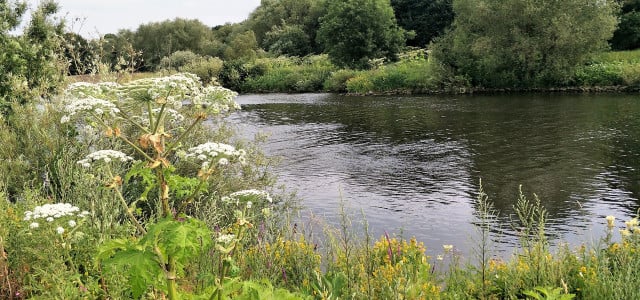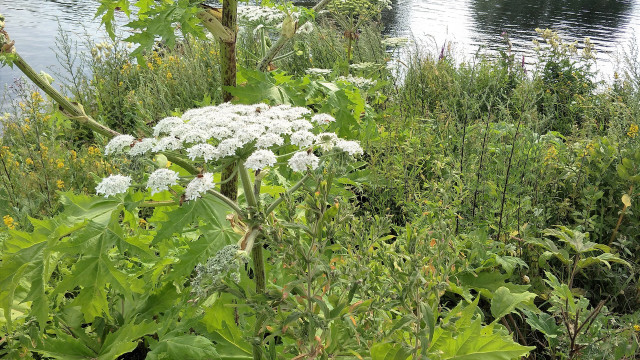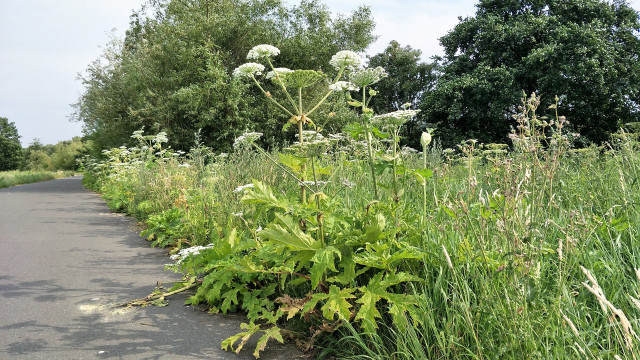
Giant hogweed (also called giant hogweed) is a poisonous plant that grows along many paths in Germany. Anyone who touches the plant can expect severe burns and should seek medical attention immediately.
The giant hogweed (Heracleum giganteum) originally comes from the Caucasus and spread throughout Central Europe during the 20th century. In the wild, the giant hogweed displaces native plant species because it is not very demanding. The giant hogweed owes its name to its size: under good conditions, the plant can grow up to four meters tall.
However, giant hogweed is very dangerous for humans: its plant sap causes burns on the skin. This is why giant hogweed was named the “Poisonous Plant of the Year” in 2018. Hobby gardeners have to protect themselves particularly well if they want to remove the plant from the garden. But there are also ecological means of controlling giant hogweed.
Giant hogweed: genus, distribution, flowering time

(Photo: Sven Christian Schulz / Utopia)
The most important information about giant hogweed:
-
Botanical name: Heracleum mantegazzianum
-
Genus: Family of Umbelliferae
-
Flower: large, white umbel flowers, approx. 80,000 flowers per plant
-
Flowering time: June and July
-
Leaves: large, serrated shape
-
Distribution: one flower produces up to 4,000 seeds
-
Distribution: all of Central Europe
-
Soil: moist, sandy-loamy soils
Because the plant has so many flowers, it is a popular food source for bees. The plant is particularly common in damp areas, such as along rivers and lakes.
Poisonous giant hogweed: warning of burns

(Photo: Sven Christian Schulz / Utopia)
The danger of giant hogweed comes from its plant sap. The phototoxic liquid (furanocoumarins) is found in all parts of the plant. In combination with sunlight, it can lead to painful burns. The affected areas of skin turn brownish, according to the Saarland Ministry of the Environment. Blisters, redness and itching are typical.
The symptoms often only appear one or two days after contact with the plant. It can take several weeks for the injuries to heal, the Ministry of the Environment explains. In addition, scars often remain.
Both animals and humans are affected. In dogs and cats, just sniffing the plants can cause skin reactions on and in their sensitive snouts. Children should only play in areas with giant hogweed wearing long clothing. Even young plants are poisonous.
First aid: If you have come into contact with the plant, you should immediately protect the affected parts of your body from sunlight and rinse them under cold running water. If a large area of skin has come into contact with giant hogweed, you should consult a doctor.
Removing giant hogweed: tips for hobby gardeners

(Photo: Sven Christian Schulz / Utopia)
Giant hogweed does not have to be reported and does not have to be removed. However, the plant spreads very quickly. So if you don’t want your whole garden to be full of giant hogweed, you should act quickly. The following should be noted:
- The best time to remove fully grown giant hogweed is on a cloudy evening in spring; for young plants, the end of October is best.
- To prevent the plant from sprouting again, you have to remove the roots, which extend about ten centimeters into the soil. A weed puller is ideal for this.
- You can dispose of the plants in the general waste. Do not throw them on the compost, as they can continue to spread there.
- Protect yourself with waterproof clothing, safety glasses and thick rubber gloves. Full-body suits are the best choice.
The method mentioned here is recommended by the Saarland Chamber of Agriculture. However, it is only suitable for smaller areas. If the entire meadow is already infested with giant hogweed, you must plough it regularly. It is important to repeat this over and over again, as the seeds will germinate again. You should sow fast-growing, dense grasses that deprive the giant hogweed seeds of the light they need to germinate.
There are also chemical pesticides that are effective against giant hogweed. However, their use is prohibited near water – that is, exactly where the plant prefers to grow. In general, you should avoid using chemical agents, as they can also harm other plants and animals or get into the groundwater.
By the way: In many regions, sheep or Scottish Highland cattle are used to combat giant hogweed. The poison doesn’t affect them because they have thick fur and dark lips. This means that only a small amount of UV radiation reaches the animals’ skin.
Read more at Techzle\.com:
- Documentary tip: Poison in the garden
- Plants against mosquitoes: How to keep your terrace, garden and balcony free of mosquitoes
- Killing weeds in the lawn: How to do it without chemical killers
** marked with ** or orange underlined Links to sources are partly affiliate links: If you buy here, you are actively supporting Techzle\.com, because we then receive a small part of the sales proceeds. .